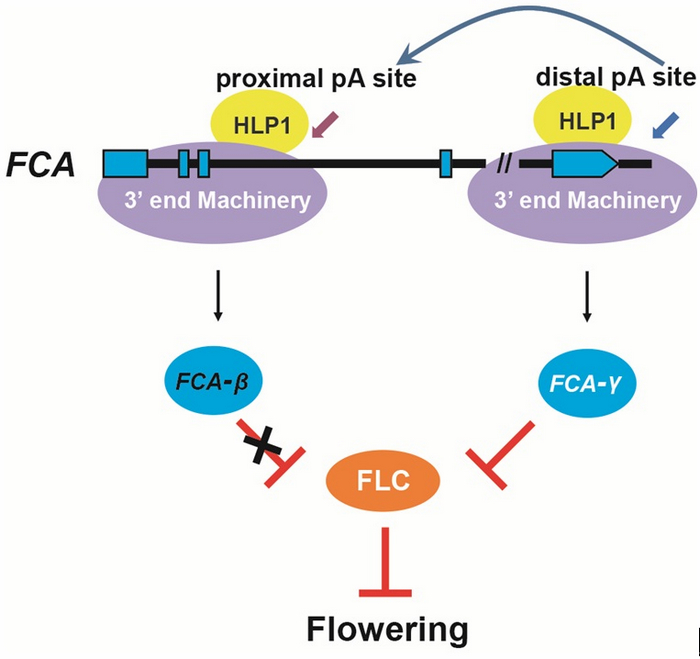Alternative polyadenylation (APA) generates mRNAs with distinct 3′ ends and is now emerging as a pervasive mechanism for gene regulation. More than 70% of yeast, Arabidopsis and mammalian genes, ~50% of Drosophila and zebrafish genes and ~30% of nematode protein-coding genes have APA sites. APA is an important post-transcriptional regulatory event and a conserved mechanism impacting both normal development and the pathophysiology of diseases. APA enormously magnifies the diversity and complexity of the transcriptome and proteome; therefore, understanding the mechanisms that direct both gene-specific and global APA will provide key insights into gene regulation.
Flowering, the transition from vegetative to reproductive growth, is a central event in the life cycle of plants. Due to its importance in ensuring reproductive success, flowering is under the most complex control that integrates environmental cues and endogenous signals. Both transcriptional and post-transcriptional regulations have been implicated in flowering, but the precise mechanism remains to be further depicted.
Researchers from Dr. CAO Xiaofeng’s group in the Institute of Genetics and Developmental Biology, Chinese Academy of Sciences, addressed these important questions. They characterized HLP1, an hnRNP A/B protein as a novel regulator for pre-mRNA 3′-end processing in Arabidopsis. Genetic analysis revealed that HLP1 suppresses Flowering Locus C (FLC), a key repressor of flowering in Arabidopsis. They established HITS-CLIP/CLIP-Seq technique (High-throughput sequencing of RNAs isolated by the cross-linking immunoprecipitation) in higher plant for the first time to delineate a global view of the regulatory circuitry directed by HLP1. Genome-wide mapping of HLP1-RNA interactions indicated that HLP1 binds preferentially to A-rich and U-rich elements around cleavage and polyadenylation sites, implicating its role in 3′-end formation. HLP1 was significantly enriched at transcripts involved in RNA metabolism and flowering. Comprehensive profiling of the poly (A) site usage revealed that HLP1 mutations cause thousands of poly (A) site shifts. A distal-to-proximal poly (A) site shift in the flowering regulator FCA, a direct target of HLP1, led to upregulation of FLC and delayed flowering.
These findings elucidate that HLP1 is a novel factor involved in 3′-end processing and controls reproductive timing via targeting APA. This is also the first protein-RNA interaction map in plants, providing the in vivo locations of HLP1 binding sites that shed light on the its regulatory roles. Many of the genes regulated HLP1 are involved not only in flowering time regulation, but also in other responses to internal and external stimuli. Therefore, the genomic resources generated in this study will be valuable for future research into the role of APA in other key responses. Considering the conservation hnRNP proteins, the idea that hnRNP proteins regulate developmental processes by targeted APA may reflect a conserved post-transcriptional mechanism in eukaryotes.
This work was published in Cell Research advance online publication on June 23, 2015 (DOI:10.1038/cr.2015.77). The postdoctoral fellows ZHANG Yong and GU Lianfeng, visiting graduate student HOU Yifeng are the co-first authors of this work. This work was supported by National Basic Research Program of China, the National Natural Science Foundation of China, the Transgenic Project, and the State Key Laboratory of Plant Genomics.
Figure. Working model for HLP1-directed APA of FCA in the regulation of flowering. (Image by IGDB)
CONTACT:
Dr. CAO Xiaofeng
Institute of Genetics and Developmental Biology, Chinese Academy of Sciences,
Beijing, China.
E-mail: xfcao@genetics.ac.cn
 Figure. Working model for HLP1-directed APA of FCA in the regulation of flowering. (Image by IGDB)CONTACT:
Figure. Working model for HLP1-directed APA of FCA in the regulation of flowering. (Image by IGDB)CONTACT: CAS
CAS
 中文
中文




.png)
